City walls of Gdańsk
| City walls of Gdańsk | |
|---|---|
Mury miejskie w Gdańsku | |
 | |
| General information | |
| Type | Defensive wall |
| Town or city | Gdańsk |
| Country | Poland |
| Designated | 8 September 1994 |
| Part of | Gdańsk – city within the 17th-century fortifications |
| Reference no. | M.P. 1994 nr 50 poz. 415[1] |
The Main City in Gdańsk is surrounded by a system of city walls dating back to the 14th century and rendered obsolete by the 16th and 17th centuries; most of the old walls no longer exist today.
History
Following the Teutonic takeover of Gdańsk in 1308, a long dispute ensued between the Kingdom of Poland and the State of the Teutonic Order regarding ownership of the city. In 1343, after the dispute was settled and Poland recognized Teutonic rule over Gdańsk, renamed to Danzig, the Main City was granted city rights and work began on fortifying the settlement.[2]
By 1370, most of the fortifications were complete. In 1379, the city received permission from the Teutonic Order to dig a moat, followed by a second layer of walls in 1380. The fortifications became more robust in 1409 and 1410. Although most of the city gates were completed in the 14th century, they were expanded and renovated well into the 16th. Due to the development of artillery, the walls became obsolete and the area beyond them was built up in the late 16th century, though some parts survive to this day, heavily damaged.[3] New 17th-century fortifications caused the 14th-century walls to lose all importance.[4]
Despite repeated attempts at conservation by the Gdańsk Museum, the city walls are today in a state of severe disrepair.[5]
Archaeological and reconstruction efforts
In the 1950s, some areas of the walls were reconstructed, though not faithfully and unsuccessfully, with another unsuccessful attempt occurring in the 1970s. The walls of the Main City were officially put on the heritage register in 1959. Archaeological excavations were conducted on the former site of the walls in 2005 and 2006, further determining details about their size and shape and contributing to reconstruction efforts.[4]
Course and components
The first part of the walls to be completed was the Corner Tower (Polish: Baszta Narożna), located at the intersection of two of the faces of the fortifications. In the south, they continue down what is now Za Murami Street and later Ogarna Street, until their eventual arrival at the shore of the Motława.[6] Going north (up the western side of the walls), they passed by the Torture Chambers in Gdańsk, the Targ Węglowy, and then north up Latarniana Street, where they turned to the east.[7] In the north, they go east down Podwale Staromiejskie Street, also meeting the Motława.[2]
List of city gates
The following is an organized list of the city gates, starting in the southeastern corner:[2]
| Image | Name in English | Name in Polish | Notes |
|---|---|---|---|
| Anchorers' Gate | Brama Kotwiczników | Destroyed during World War II, with only a fortified tower remaining[8] | |
| Frog Gate | Brama Żabia | Taken apart in the early 19th century, ruins rediscovered in 1945[9] | |
| Gate on the Excesses | Brama na Zbytkach | Progressively taken apart in the 18th and 19th centuries, with the rest being destroyed in 1945[10] | |
| Cirque Gate | Brama Karowa | Covered up in 1563, taken apart in 1896[11] | |
| Long Street Gate | Brama Długouliczna | Replaced by the Golden Gate in 1611[12] | |
| Ludwig Gate | Brama Ludwisarska | Demolished in 1803[13] | |
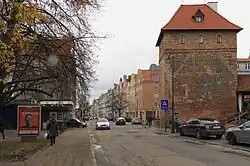 |
Wide Gate | Brama Szeroka | Demolished in the mid-19th century, with only a fortified tower remaining[14] |
| Castle Gate | Brama Zamkowa | Demolished following a fire in 1880[15] | |
| Tobias' Gate | Brama Tobiasza | Rebuilt in 1884 and destroyed in 1945[16] | |
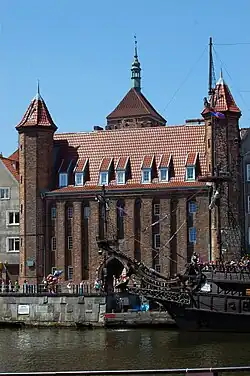 |
Market Stall Gate | Brama Staganiarska | Exists to this day |
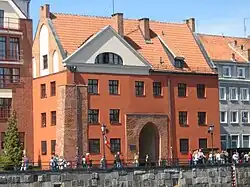 |
St. John Gate | Brama Świętojańska | Exists to this day |
| Gdańsk Crane | Brama Żuraw | Exists to this day as a major tourist attraction[17] | |
| Holy Spirit Gate | Brama św. Ducha | Exists to this day | |
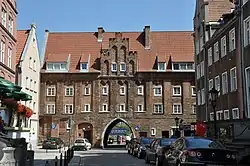 |
Bread Gate | Brama Chlebnicka | Exists to this day |
 |
Cog Gate | Brama Kogi | Replaced by the Green Gate in 1564[18] |
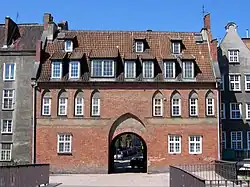 |
Cow Gate | Brama Krowia | Exists to this day |
References
- ^ Zarządzenie Prezydenta Rzeczypospolitej Polskiej z dnia 8 września 1994 r. w sprawie uznania za pomnik historii., M.P., 1994, vol. 50, No. 415
- ^ a b c Mamok, Szymon. "Budowle obronne Głównego Miasta (1343-1519)". historiagdanska.pl. Retrieved 22 July 2025.
- ^ "Gdańsk – miejskie mury obronne". medievalheritage.eu. Retrieved 22 July 2025.
- ^ a b "mury obronne Głównego Miasta". zabytek.pl. National Institute of Cultural Heritage. Retrieved 22 July 2025.
- ^ "A mury runą, runą, runą! – galeria". gdanskastrefa.com. 15 October 2024. Retrieved 22 July 2025.
- ^ Ślubowski, Michał (23 March 2025). "Średniowieczne mury Głównego Miasta. Część 1". trojmiasto.pl. Retrieved 22 July 2025.
- ^ Ślubowski, Michał (13 April 2025). "Spacer wzdłuż średniowiecznych murów Głównego Miasta. Część 2". trojmiasto.pl. Retrieved 22 July 2025.
- ^ "Baszta Kotwiczników". trojmiasto.pl. Retrieved 22 July 2025.
- ^ Stąporek, Marcin (2004). "Brama Żabia". rzygacz.webd.pl. Archived from the original on 4 May 2013. Retrieved 22 July 2025.
- ^ Januszajtis, Andrzej. "BRAMA NA ZBYTKACH". gedanopedia.pl. Retrieved 22 July 2025.
- ^ Sulikowski, Grzegorz. "BRAMA KAROWA". gedanopedia.pl. Retrieved 22 July 2025.
- ^ Januszajtis, Andrzej. "BRAMA DŁUGOULICZNA". gedanopedia.pl. Retrieved 22 July 2025.
- ^ Śliwiski, Błażej. "BRAMA LUDWISARSKA". gedanopedia.pl. Retrieved 22 July 2025.
- ^ Gliński, Mirosław. "BRAMA SZEROKA". gedanopedia.pl. Retrieved 22 July 2025.
- ^ Śliwiński, Błażej. "BRAMA ZAMKOWA". gedanopedia.pl. Retrieved 22 July 2025.
- ^ Śliwiński, Błażej. "BRAMA TOBIASZA (Tobiastor)". gedanopedia.pl. Retrieved 22 July 2025.
- ^ "Gdański Żuraw otwarty. Zaglądamy do środka razem z pierwszymi zwiedzającymi". gdansk.pl. 30 April 2024. Retrieved 22 July 2025.
- ^ Załęska, Jagoda. "BRAMA KOGI". gedanopedia.pl. Retrieved 22 July 2025.